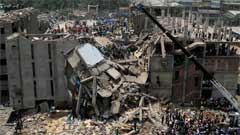 |
May 16, 2013 - Supply Chain Newsletter |
 |
| FEATURED SPONSOR: PTC |
 |
Early Visibility into Product and Supply Chain
Risks Helps
|
 |
|
||||||||||||||||||||||||||||||||||||||||||||||||||||
Right Product, Right Place, Right...
|
|||||||||||||||||||||||||||||||||||||||||||||||||||||
| GILMORE SAYS: |
"There was certainly not enough time for a more informed discussion of what should be in the agreement or a vigorous review of the full legal implications." WHAT DO YOU SAY? |
This disaster after a series of apparel factory fires in the country, which has grown its apparel export business from $5 billion 10 years ago to more than $18 billion in 2012, representing 79% of its total exports and employing millions there. Those earlier fires killed dozens, while a fire at an apparel factory in Pakistan last November killed 112. There was another fire in Bangladesh just last week that killed eight more.
Houston, we have a problem. All this now some 20 years after Nike (the poster child for labor activists' scrutiny, rightly or wrongly) was first targeted for sourcing from "sweat shops" that often used child labor.
I predicted after the Pakistan fire that we would see changes soon in the apparel supply chain, and we did - at least at Walmart. That's because it turned out clothes for Walmart (as well as Sears and others) were being made at the fatal Pakistani factory, unbeknownst to Bentonville. How? Through a very murky supply chain where use of sub-contractors is widespread. I believe the Walmart order went to a tier 1 Canadian supplier, which used an agent in India to sub-contract part of the order to the Pakistani facility.
Earlier this year, Walmart then changed a number of its apparel sourcing policies, including banning use of sub-contractors without getting approval or using an approved vendor, changing from a "three strikes and you're out" approach for vendor violations to one in which you can be dismissed for a single issue, and banning use of third-party contractors for inspections by the tier 1 companies in favor of direct employees, among other changes.
Then came the collapse in Bangladesh. I predicted that again we would see more changes in the apparel supply chain, and we have - rapidly. But that response raises some questions, with implications for all of us.
First, when it turned out that the factory there was making clothes for Canada's Loblaw's chain and Europe's Primark brand, the two companies separately announced they would financially compensate the families of those killed and as well as the individuals who were injured. This may be a first - companies compensating victims of an accident at independent suppliers. Details on the compensation levels are not available, but I have never heard of this happening before.
"We are fully aware of our responsibility," Primark said in a statement. "We urge these other retailers to come forward and offer assistance."
Very interesting - perhaps precedent setting, and now a new risk to contend with.
Now, just three weeks after the Bangladesh building collapse, some other interesting developments, to say the least.
Swedish fashion retail H&M quickly dusted off a Bangladesh sourcing agreement developed in 2012 and put public pressure on other retailers and brand companies to sign on.
The six-page, legally-binding agreement, called the "Accord on Fire and Building Safety in Bangladesh," lasts five years, and stipulates that the retailers/brands will not to hire manufacturers whose apparel factories fail to meet safety standards and then refuse to make improvements. For those that will make improvements, the signees will be committed to paying for necessary repairs and renovations - and that could certainly be a large expense. The agreement also includes an independent inspection program with public reports of all the results, specifying, for example, that signees must inspect no fewer than 30% of the facilities of their tier 1 suppliers annually.
This again is simply unprecedented, and the process was curious. H&M said that May 15 must be the deadline for jumping on the bandwagon, just a week after the accord was first promoted. That was certainly not enough time for a more informed discussion of what should be in the agreement or a vigorous review of the full legal implications.
A few Euro retailers and brands quickly signed on, then as the artificial May 15th deadline approached, many more jumped in, including Inditex (parent of Zara), C&A, Carrefour, Marks & Spencer, TESCO, Primark, PVH, and several others.
 Notably absent were US companies, with the Gap, for example, saying it was concerned about the implications of the agreement in the US court system. That concern was generally considered unacceptable in the court of global opinion, however.
Notably absent were US companies, with the Gap, for example, saying it was concerned about the implications of the agreement in the US court system. That concern was generally considered unacceptable in the court of global opinion, however.
"Gap calls itself a leader on social responsibility," said Scott Nova, executive director of the Worker Rights Consortium this week. "The opposite is the case. Gap and Walmart are laggards."
Really? That because they weren't quite ready to sign the paper after seven days of review time?
Walmart then chose Plan B, announcing its own program - notably making its announcement on May 15, so it didn't miss the fake Euro deadline for this.
Walmart's plan will force suppliers with deficiencies in their buildings to make repairs or risk being dropped from the company's approved list of suppliers. Unlike the European agreement, Walmart will not directly provide any funds for such structural or operational improvements. But a company executive said that Walmart will absorb price increases in the cost of the goods it buys if suppliers need that increase to fund their investments. We'll see.
Got all that? This really is a new supply chain universe. There are clearly major issues in the apparel supply chain. But rather than those issues driving country governments to clean up their own houses, Western companies are pressured to not just choose safe suppliers that treat workers well (which has been the story for some time but apparently not in the end all that effective), but to actually now make investments in their suppliers' infrastructure. Would think the return on invested capital is not too high on that. This seems to me to be a major supply chain inflection point. I am not quite sure what to make of it. Where does that go from here?
To me, there all kinds of questions in this Euro plan. Exactly how much financial support that must be provided is unclear, for example. How sums would be allocated across retailers and brands even less so. Does a company need to provide funding if it just uses a supplier for a one-off order, for example? Who knows.
And to me, noticeably, the Euro accord and Walmart's program apply only to sourcing from Bangladesh, not other low cost countries with largely similar conditions. And as costs rise in Bangladesh (the government says it will raise the minimum wage and make it much easier to unionize too), will the easiest path be to just move to Cambodia and avoid all this until a disaster hits there too?
Of course, Apple went through much of this same thing in 2011-12 (Foxconn, et al) , and it truly raised the bar in terms of auditing its own supply chain and reporting on the results.
If you think this scenario will be limited to companies in the apparel and high tech industries, think again. If you are sourcing from low cost countries directly or indirectly, this will find you soon.
So, back to the title of this column: For years we've operated in the supply chain under the notion of "right product, right place, right time and (sometimes used) right price." This needs updated. We have moved now to "right product, right place, right time, right price, right profit (more on this soon) and right...social responsibility?"
Need a more simple term for that last one to be consistent. Right "values" perhaps? But you get the idea. And it is real. The equation has changed forever. Time to make that clear to all.
What do you make of all these developments? Is this an inflection point? Should we add "right social responsibility" to the paradigm? Let us know your thoughts at the Feedback button (email) or section (web form) below.
![]()
| View Web/Printable Version of this Page |
|
|
|
YOUR FEEDBACK
Some good Feedback on our recent First Thoughts piece on A Unified Theory of Out-of-Stocks, in which SCDigest editor Dan Gilmore ponders on the OOS problem that never seems to go away.
That includes our Feedback of the week from Andre' Martin - who just happened to create the concept of Distribution Requirements Planning (DRP) more than three decades ago. More next week.
Feedback of the Week - On Unified Theory of Out-of-Stocks:
The Out-of-Stocks problem in the CPG Industry has been around a very long time and will not go away until we completely change our thinking on how to manage the end to end retail supply chain. First, we need to acknowledge some basic truths learned the hard way: 1. The retail store is the beginning & the end of the retail supply chain. It's the beginning of information flow and the end of product delivery. Having wrapped our brains around these basic truths we then need to take advantage of major breakthroughs that have occurred recently. Today, it is possible for a retailer and a manufacturer to model and connect their retail supply chain inside a single computer and drive it, end to end, from a unique store level sales forecast. Today, it is possible to resynchronize every node making up a retail supply chain every day based on changes in store level consumer demand and thus completely eliminate the "Forrester Effect" (also called the Bullwhip Effect). Today, it is possible for a retailer and a manufacturer to use this model of their retail supply chain and manage it as if one company were managing it. Today, it is possible for a retailer and a manufacturer, using this "business model, to create an Integrated Business Plan, identify gaps and take corrective action while there is still time. Today, there are no secrets anymore on how to manage the end to end retail supply chain, from the store to the factory, and significantly lower store out-of-stocks as well as reduce retailer's and supplier's inventories and operating cost at the same time. Today, it is possible to achieve a 99.8% On Shelf Availability (OSA) at the store while reducing overall supply chain inventory buffers at the same time. Today, there is a proven and well documented business process, and enabling technology, to actualize all of the above and it even has a name: It is called "Flowcasting the Retail Supply Chain."
Editor's Note: Martin invented the concept of Distribution Requirements Planning in the 1970s.
|
||
| Unified Theory of Out-of-Stocks: | ||
I am a self-proclaimed retail junkie and unfortunately for my wife salivate at the topic of OOS. I firmly believe that some retailers can capitalize on the OOS with behavior modification, especially soft line retailers. E.g. The Banana Republics or similar when faced with OOS situation can promise to ship the item for free to the consumer. Yes, they might incur some additional costs, but at least they will not lose the sale. Retail statistics indicate that the big box stores and malls in general are going to facing a decline in foot traffic due to increasing online sales, so in order exist they will have to begin to transition their customer and staff towards a greater online presence. Raj Daniels |
||
| Really appreciate your article on this subject as we have been researching and working this problem at Clemson University in our model factory since the late 90's. Our original R&D work and proof of concept solution was funded by the Department of Defense. A small group of us has formed a spin-off company to continue the perfection of the solution and make it available beyond the DoD. The Army has successfully used the solution for all combat apparel since 2005 and three commercial companies have also had great success with it. Our approach is a SAAS tool that synchronizes consumer demand through distributors and manufacturers up as many tiers of the extended supply chain as we can get to work together (and getting two or more companies to work together in a different manner is extremely difficult). We achieve synchronization based on the simple concept that everyone who orders replenishment, determines what to ship in VMI situations, or schedules production should order, ship, or make next that which is in shortest supply downstream of their location in the supply chain. We do this by creating standard structured "supply chain sections" throughout the supply chain as basic, but very flexible building blocks that use the same algorithms to compute what should be ordered, shipped, or manufactured next subject to existing constraints and always balanced in days-of-supply. These computations are based on current inventory levels, lead-times, and strategic buffer stockage objectives set in days-of-supply. We use forecasts, but minimize the common problem of forecast error by running the tool frequently to re-balance all supply chain sections and thus replace most of the forecast with demand pull driven by downstream shortages. Our results virtually eliminate stock-outs of replenishable products, shorten replenishment lead-times so that many non-replenishable products become replenishable during the selling season, reduce inventories by 50 to 90 percent, virtually eliminate expediting, and minimize resources required to generate replenishment orders as well as shipment and production schedules. If you are interested in our work, we would like for you to visit us and learn more about our approach and our accomplishments at Clemson. Bill Kernodle
|
||
SUPPLY CHAIN TRIVIA ANSWER
Q: What logistics problem was Fred Smith originally trying to solve with the launch of Federal Express in 1971?
A: Getting spare/repair parts for computers and other products to customers more quickly. The uses for overnight delivery expanded from there.
| © SupplyChainDigest™ 2003-2013. All Rights Reserved. SupplyChainDigest PO Box 714 Springboro, Ohio 45066 |
POWERED BY: XDIMENSION
|







